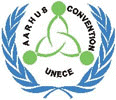




Back
to Top




Back
to Top
Back
to Top
Back
to Top
Back
to Top
Back
to Top
Back
to Top
Back
to Top
Back
to Top
Back
to Top
Back
to Top
Back
to Top
Back to Top
Back to Top
Back to Top
Back to Top
Back to Top
Back to Top
Back to Top
Back to Top
Back to Top
Back
to Top
Back
to Top
Back
to Top
Back
to Top
Back
to Top
Back
to Top
|
Sustainable
Design(1) & Construction
The
ethical response, in built or wrought form, to the concept of
'Sustainable Human & Social Development'.
(1) Includes
Spatial Planning, Architectural/Engineering/Industrial Design
& e-Design.
Publications & Documents
Sustainable Human & Social Development
Development which meets the responsible needs, i.e.
the Human & Social Rights(2), of this generation
- without stealing the life and living resources from future
generations, especially our children ... and their children ... and the next five generations of children.
(2)
As defined in the 1948
Universal Declaration of Human Rights (UN OHCHR).
Inspired by the Culture of the North American Indigenous Peoples ... this definition incorporates the concept of '7 Generation Thinking'.
| 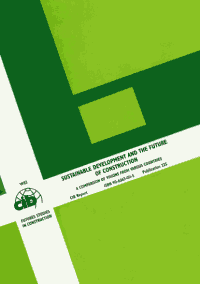
|
CIB Report 225, May 1998
Sustainable
Development and
the Future of Construction
Click
Here to View
National Report No.5 : Ireland
C J Walsh
|
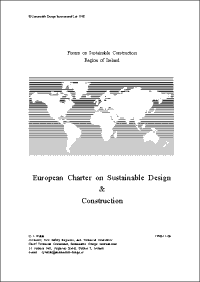
|
C J Walsh
1998
European Charter on Sustainable
Design & Construction
(adopted Dublin, 6th November 1998)
Click
Here to View Original Charter
Click Here
to Download Original PDF
(PDF File, 72kb)
|
|
The structure
of the European Charter on Sustainable Design & Construction
reflects the fundamental view that Sustainable Construction
is the response, in built form, to the concept of 'sustainable
development', and it's initial formal elaboration at global
level - the Rio Declaration of 27 Principles,
with Agenda 21 (detailed supporting guidance) - both
agreed at the United Nations Conference on Environment and
Development which was held in Rio de Janeiro. Brazil, during
June 1992.
It is
Sustainable Design, however, which will direct the
future course of this innovative approach to construction.
For the first time in the European Charter, a comprehensive
scope of concern, relating to ethics and values, is outlined
for the subject ; a rational decision making framework is
presented ; human development, social injustice and inclusion,
environment and energy issues are discussed in coherent format
; and finally, technical terms are defined for better communication.
The European
Charter on Sustainable Design & Construction preserves
the legal intent of the 1992 Rio Declaration on Environment
and Development.
This CIB Publication below references the European Charter
....
|
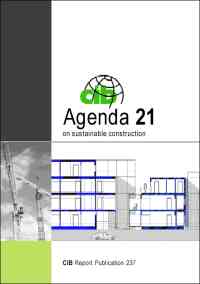
|
CIB Publication 237, July 1999
Agenda 21 on Sustainable
Construction
Click
Here to Download PDF File
Directly from CIB WebSite
( 30.6Mb ! )
|
|
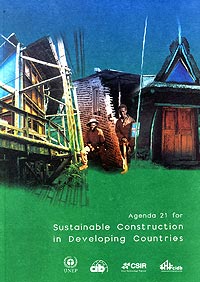 |
2002 CIB & UNEP-IETC
Discussion Document
Agenda
21 for Sustainable Construction
in Developing Countries
Click
Here to Download PDF
(PDF File, 1.58Mb)
|
This is an interesting document. However, it only begins to
come alive on Page 11 ......
' The
model of social and economic equity, which underpins Agenda
21, is mainly based on the Western liberal democratic
value system shaped by the previous millennium's social revolutions
in Europe. Increasing scepticism from the developing world
suggests that Sustainable Development, as
promoted and practiced by the international development agencies,
is just business as usual, and that despite the lip service
to "harmony with local cultural and spiritual values"
it often conflicts with the values held by the non-industrialized
countries, or at best does not acknowledge the validity of
other value systems. There is also scepticism about the ability
of the West to provide the real solutions to problems which
were essentially created by their development model.'
By responding
appropriately to local geography, climate, economy, culture
and social need ...... and while still adhering to the Principles
of Sustainable Human & Social Development ......
Sustainable Design & Construction must
adopt a different form in each Global Region of the World.
The
World, and our future generations, cannot afford a Western
liberal democratic value system !
|
|
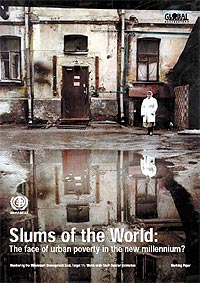 |
2003 UN-HABITAT Working Paper
Slums
of the World: The Face of Urban Poverty in the New Millennium
?
Click
Here to Download PDF
(PDF File, 7.96Mb)
|
In 1950, one-third of the world's people lived in cities. Just
fifty years later, this proportion has risen to one-half and
will continue to grow to two-thirds, or 6 billion people, by
2050. In terms of population densities, spatial distribution,
economic activity and social attitude, the world has become
urbanized. After a half-century of intense global urban growth,
the United Nations and its individual member states now recognise
the powerful developmental role that cities play, as well as
the challenges they face. In
a world of liberalized trade and finance, cities are focal
points for investment, communication, commerce, production
and consumption. They are magnets for immigrants and for others
seeking a better life, as well as the locus of problems that
result from these profound economic and demographic trends.
The most alarming accompaniment to urbanization in this globalizing
world has been the deepening of urban poverty and the growth
of slums that now envelop nearly one billion people worldwide.
The United
Nations Millennium Declaration recognizes the dire
circumstances of the world's urban poor, articulating member
states' commitment to improve the lives of at least 100 million
slum dwellers by the year 2020. As large as 100 million may
seem, however, it is only ten percent of the present worldwide
slum population which, left unchecked, will multiply threefold
to 3 billion by the year 2050.
The problem
of slums is a dynamic one. At any point in time and in any
one place, it may present itself as a cluster of symptoms
which might be dealt with sector-by-sector until the problem
begins to dissolve. There are, however, economic, social and
political forces behind the urban poverty which cause slums
to form at a rate that overwhelms every effort to fight them.
It is those forces that must be challenged and channelled,
not just within the slums but also in the wider urban and
regional context. Fundamentally, urban poverty and slums are
not just a matter of local improvement but of region-wide
and national development policy.
Achieving
Sustainable Urbanization requires the balanced integration
of social, economic, political, institutional and environmental
objectives into a coherent overall framework.
|
|
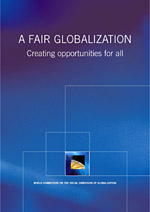 |
2004 Report
World Commission on the Social Dimension
of Globalization (WCSDG)
'A Fair Globalization:
Creating Opportunities for All'
Click
Here to Download PDF
(PDF File, 2Mb)
|
A Vision for Change
Public debate on globalization is at an impasse. Opinion is frozen in the ideological certainties of entrenched positions and fragmented in a variety of special interests. The will for consensus is weak. Key international negotiations are deadlocked and international development commitments go largely unfulfilled.
The report before you offers no miraculous or simple solutions, for there are none. But it is an attempt to help break the current impasse by focusing on the concerns and aspirations of people and on the ways to better harness the potential of globalization itself.
Ours is a critical but positive message for changing the current path of globalization. We believe the benefits of globalization can be extended to more people and better shared between and within countries, with many more voices having an influence on its course. The resources and the means are at hand. Our proposals are ambitious but feasible. We are certain that a better world is possible.
We seek a process of globalization with a strong social dimension based on universally shared values, and respect for human rights and individual dignity; one that is fair, inclusive, democratically governed and provides opportunities and tangible benefits for all countries and people.
To this end we call for:
- A Focus on People
The cornerstone of a fairer globalization lies in meeting the demands of all people for: respect for their rights, cultural identity and autonomy; decent work; and the empowerment of the local communities they live in. Gender equality is essential.
- A Democratic and Effective State
The State must have the capability to manage integration into the global economy, and provide social and economic opportunity and security.
- Sustainable Development
The quest for a fair globalization must be underpinned by the interdependent and mutually reinforcing pillars of economic development, social development and environmental protection at the local, national, regional and global levels.
- Productive and Equitable Markets
This requires sound institutions to promote opportunity and enterprise in a well-functioning market economy.
- Fair Rules
The rules of the global economy must offer equitable opportunity and access for all countries and recognize the diversity in national capacities and developmental needs.
- Globalization with Solidarity
There is a shared responsibility to assist countries and people excluded from or disadvantaged by globalization. Globalization must help to overcome inequality both within and between countries and contribute to the elimination of poverty.
- Greater Accountability to People
Public and private actors at all levels with power to influence the outcomes of globalization must be democratically accountable for the policies they pursue and the actions they take. They must deliver on their commitments and use their power with respect for others.
- Deeper Partnerships
Many actors are engaged in the realization of global social and economic goals – international organizations, governments and parliaments, business, labour, civil society and many others. Dialogue and partnership among them is an essential democratic instrument to create a better world.
- An Effective United Nations
A stronger and more efficient multilateral system is the key instrument to create a democratic, legitimate and coherent framework for globalization.
|
|
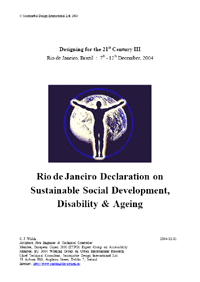 |
|
Many individuals and organizations were involved in the development
of the 2004 Rio Declaration. We are very grateful for
all of their contributions.
Further comments will be welcomed !
The words 'green', 'environmental', 'ecological' and 'sustainable'
are becoming part of everyday language in the Developed World,
but are frequently interchanged without understanding. To
date, however, the concept of Sustainable Development has
been hijacked by Environmentalists. For example, no
connection at all may be seen between a 'sustainable' building
and ensuring that it can be safely and conveniently entered
and used by ordinary people.
In
other parts of the World, the ambiguous WCED/Brundtland
Definition of Sustainable Development is being systematically
rejected; the concept is viewed as an unaffordable luxury
and/or as a means of continued domination and control by the
'North'. Yet, sustainability must be a global compact.
In this
intolerant and more fundamentalist 21st Century, the United
Nations System, International Law, and Social Justice continue
to come under sustained attack. And the Beslan Tragedy
demonstrates that it is far more hazardous for disadvantaged,
vulnerable and indigenous peoples in every society.
Some specific
objectives for the 2004 Rio Declaration were
as follows ...
- To
present a 2nd Generation Definition of Sustainable Development
which is more acceptable to the Developing World;
- To
restore primacy to the Social Aspects of Sustainable Development
... and particularly the ethical values of Social Justice,
Solidarity and Inclusion-for-All;
- To
embed the concept of the 'Person' in Sustainable Development
... rather than the fleeting reference to 'People' which
too often results in Disadvantaged, Vulnerable and Indigenous
Groups being left behind;
- To
signal one of the main challenges of Sustainable Development
ahead - which will be to establish a framework of horizontal
co-ordination at the many institutional levels ... and between
the many actors and end users ... in the human environment.
Adopted
in December 2004, at the Brazil Designing for the 21st Century
III Conference, the Rio Declaration consists of a Preamble,
10 Principles and 5 Appendices;
its central concern involves People with Activity Limitations.
This Declaration
extols implementation, and the targeting and monitoring of
'real' performance - as opposed to 'imagined' or 'paper' performance.
Designing
for the 21st Century III Conference WebSite
Rio
de Janeiro, Brazil : 7th-12th December 2004
|
Friday
Evening, 10th December 2004
Setting the Scene for the 2004 Rio Declaration
....
C
J Walsh Extended Keynote Presentation (Director's Cut)
Click
Here to Download PDF
(PDF File, 2.2Mb)
Saturday Afternoon, 11th December
2004
Informal
Roundtable Discussion on the 2004 Rio Declaration
Click
Here to Download Declaration PDF
(PDF File, 1.21Mb)
Two
important matters were raised at the Roundtable Discussion :
• The use and meaning of 'Social Rights' in the Declaration
should be clarified ....
On page 27 (Appendix IV), the Declaration now states in bold text
: 'Social Rights, as
distinguished here, include and extend beyond current understandings
of civil, political, economic, social and cultural rights.'
Environmental rights, for example, must also be considered.
Paragraph 4 in the Explanatory Memorandum now advises the reader
to see the definition of 'Social Rights'.
• Principle 1 should include a reference to the 1994 UNESCO
Salamanca Statement
on Special Needs Education.
Completed. This is an important reference document concerning
the education of all students .... everywhere !

Accompanying
Statement - Proposed UN Convention on Disability
Click
Here to Download Statement PDF
(PDF File, 67kb)
An important 'plug-in' to the 2004 Rio Declaration
(Principle 5) will be ...
Ethical
Principles for Design, Research & Construction
in the Human Environment
Model
Document for this Work
World
Medical Association's Helsinki Declaration
Click
Here to Download PDF
(PDF File, 116kb)
Further Issues To Be Examined ....
Human
& Social Rights in the Context of Sustainable Development
Do
Design Philosophies Hinder or Help the Implementation of
Effective Accessibility ?
-
universal design
- design-for-all
- inclusive design
- barrier-free design
- facilitation design, etc, etc.
Sustainable
Economic Development & Ethical Globalization
Standard
Use of Elevators/Lifts for Evacuation of People with Activity Limitations
During a Fire Incident
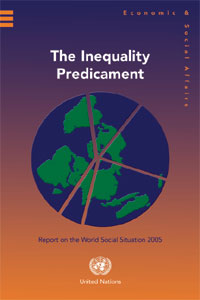
|
United Nations Report
'The Inequality Predicament'
&
The World Social Situation in 2005
Click Here to Download PDF File
(PDF File, 1.18Mb)
|
The global commitment to overcoming inequality and redressing the imbalance between wealthy and poor, as clearly outlined at the 1995 Copenhagen World Summit for Social Development and endorsed in the 2000 United Nations Millennium Declaration, is fading. 80% of the World’s Gross Domestic Product (GDP) belongs to the 1 Billion People living in the developed world; the remaining 20% is shared by the 5 Billion People living in developing countries. Failure to address this inequality will ensure that social justice and better living conditions for all people remain elusive, and that communities, countries and regions remain vulnerable to social, political and economic upheaval.
This 2005 Report on the World Social Situation traces trends and patterns in economic and non-economic aspects of inequality, and examines their causes and consequences. It focuses on the traditional aspects of inequality, such as distribution of income and wealth, as well as inequalities in health, education, and opportunities for social and political participation. The Report also analyses the impact of structural adjustment, market reforms, globalization and privatization on economic and social indicators.
Ignoring inequality in the pursuit of development is perilous. Focusing exclusively on economic growth and income generation as a development strategy is ineffective, as it leads to an accumulation of wealth by the few and deepens the poverty of many; and such an approach does not acknowledge the intergenerational transmission of poverty. A broader approach to poverty reduction includes social, economic and political dimensions, integrating improvements in health, education, economic development, and representation in legislative and judicial processes. It is the implementation of policies in these areas that contributes to the development of human capital, enabling the poor to realize their full productive potential. Addressing all aspects of poverty increases the odds that future generations will reap the benefits of today’s policies, rather than remaining trapped in a cycle of poverty.
Anyone involved, directly or indirectly, with the Design, Construction and Management of a Sustainable Built (including Virtual) Environment must be aware of these issues ..... and of the fundamental necessity for a broad and balanced approach, across all aspects of Sustainable Development, in their everyday practical work. This is not yet the prevailing view in most educational/academic/professional institutions !
|
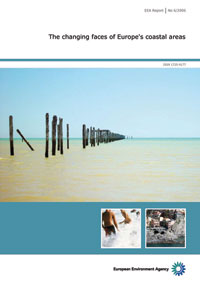
|
2006
EEA Report No.6
The Changing Faces of
Europe's Coastal Areas
Click Here to Download PDF File
(PDF File, 10.4Mb)
|
This report, from the European Environment Agency, provides information on the state of the environment in the coastal areas of Europe, and provides evidence of the need for a more integrated, long-term approach.
Since 1995, concern about the state of Europe's coastline has led to a number of European Union initiatives, which build on the concept of Integrated Coastal Zone Management (ICZM). ICZM attempts to balance the needs of development with protection of the very resources that sustain coastal economies. It also takes into account the public's concern about the deteriorating environmental, socio-economic and cultural state of the European coastline.
The specific objective of this work is to contribute to the review of the Recommendation of the European Parliament and the Council concerning the implementation of Integrated Coastal Zone Management in Europe (2002/413/EC), planned by the European Commission for 2006. This review requires information on existing trends and on the effects of policies and financial instruments directed towards coastal management.
The EEA intends to contribute to the review by promoting spatial analysis and enhancing the integration of relevant environmental data with related socio-economic data to the extent current available information allows. At the same time, the report aligns itself to the wider context of ecosystems and human wellbeing set up by the Millennium Ecosystem Assessment (2005). By linking ecosystems and human wellbeing, this approach focuses in particular on 'ecosystem services', i.e. the benefits people obtain from ecosystems.
|
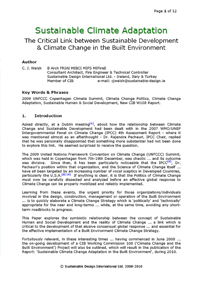
|
2010
C J Walsh
Sustainable Climate Adaptation
The Critical Link between Sustainable Development &
Climate Change in the Built Environment
Click Here to Download PDF File
(PDF File, 175kb)
|
Asked directly, at a Dublin meeting, about how the relationship between Climate Change and Sustainable Development had been dealt with in the 2007 WMO/UNEP Intergovernmental Panel on Climate Change (IPCC) 4th Assessment Report - where it was mentioned almost as an afterthought - Dr. Rajendra Pachauri, IPCC Chair, replied that he was personally disappointed that something more substantial had not been done to explore this link. He seemed surprised to receive the question.
The 2009 United Nations Framework Convention on Climate Change (UNFCCC) Summit, which was held in Copenhagen from 7th-19th December, was chaotic ... and its outcome was divisive. Since then, it has been particularly noticeable that the IPCC, Dr. Pachauri's position within that organization, and the Science of Climate Change itself ... have all been targeted by an increasing number of vocal sceptics in Developed Countries, particularly the U.S.A. If anything is clear, it is that the Politics of Climate Change must now be carefully dissected and analyzed before an effective global response to Climate Change can be properly mobilized and reliably implemented.
Learning from these events, the urgent priority for those organizations/individuals involved in the design, construction, management or operation of the Built Environment ... is to quickly elaborate a Climate Change Strategy which is 'politically' and 'technically' appropriate for the near and long-terms ... while, at the same time, avoiding any short-term roadblocks to progress.
This Paper explores the symbiotic relationship between the concept of Sustainable Human and Social Development and the reality of Climate Change ... a link which is critical to the development of that elusive consensual global response ... and essential for the effective implementation of a Built Environment Climate Change Strategy.
Fortuitously relevant, in these interesting times ... having commenced in June 2008 ... the on-going development of a CIB Working Commission 108 ('Climate Change and the Built Environment') Project will also be outlined, which will result in the publication of the Report: 'Sustainable Climate Change Adaptation in the Built Environment', during 2010. |
Synchronicity
Linking the Different Aspects of Sustainable Human & Social Development
2000 - 2010 - 2020 (?) - Another 100 Years (?)
Criminal Human, Environmental & Cultural Destruction in Iraq !
Go to This Page
on our WebSite.

|
You will need Adobe Acrobat
Reader to view the PDF files. Accessibility
of PDF for people with disabilities |

home | sustainability | fire
| architecture | copyright | synchronicity
search
this site | back to top | update | contact | technical blog
©
Sustainable Design International Limited 1995-2018
all rights reserved - tutti i diritti riservati
|

























